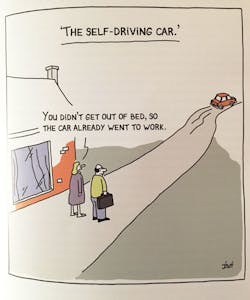The automotive sector is evolving at a breathtaking pace. From electric and hybrid power solutions to infotainment options and autonomous driving, vehicles have become feats of electrical rather than mechanical engineering. Interestingly, I learned recently on a trip to The Netherlands that the country can provide an estimated 70% of the solutions, technologies, and materials needed for current and future automobiles—without being home to an auto manufacturer of its own.
That number is staggering in a country that is not churning out innovations to support its own car brand. This reality also spotlights two things: first, how much of what is developed for today’s car exists beyond the car body and basic parts; and second, a readiness to adopt or help to create and proliferate new technologies. As one government representative told me, people often ask him when autonomous cars will be available because they’re excited about them, not because they dread them.
Despite the country’s extremely bike-friendly, green, innovative spirit, however, it is still home to a group of laggards and some late adopters, just as we are here in the United States. Marco Mare’chal emphasized the varied attitudes of the population in a nationwide opinion study titled, “The Dutch Finally Have Their Say on Mobility In The Future 2030.” The study reports that most Dutch people believe that streets will be dominated by EVs first and foremost in 2030. Yet they cite self-driving cars second and then eco-friendly cars, followed by responses of little/no change and more congestion and traffic jams (the last would clearly be the laggards). Amazingly, a hovering or flying car came in sixth place.
To me, this leap to the flying car is evident of a different way of thinking about these innovations and talking about them than we may experience in the U.S. Among the technical and research people I spoke with in The Netherlands, quite a few explained that they think about the autonomous vehicle as a robot. What defines a robot? It is a machine that has the intelligence to carry out a set of tasks that it is built and programmed to do. A driverless car does fit that definition. It follows that the same definition can be applied to other autonomous vehicles, such as drones. It’s not such a big leap, then, to imagine flying cars in the nearer future. As we add intelligence to drones, cars, and other things that move, they do become more robot than vehicle.
The Netherlands’ next step, now that it has become a breeding ground for innovations for automotive systems, is to establish itself more prominently as a testing ground. It already has conducted tests for things like driverless cars and platooning capabilities, and the country’s leaders are backing these efforts. Such tests have begun exploration into the needs of the general population, network operators, etc. For example, the country is unique in the number of bicycles used daily, so autonomous cars have to be aware that they are sharing the road with bicycles. This is just one example of the concerns and points being addressed via various regulatory groups, the government, researchers, universities, and faculty, and more.
While many other countries grapple with the question of how to begin work on autonomous vehicles and other mobility enhancements, The Netherlands has already begun experimenting with them on regular roads and in normal traffic. With this bold approach, combined with openness to innovations and deep technology roots, the country is increasingly attracting a talented international workforce and student body. Certainly, its progress bears watching as the world looks to adopt enhanced mobility solutions.


